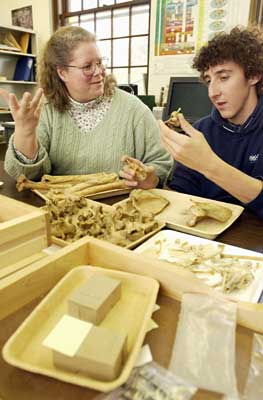Zooarchaeology Laboratory
Director: Kristin D. Sobolik

Zooarchaeological Laboratory Research Projects:
Zoogeography Project of Maine involves the analysis of the prehistoric faunal record to map migrations and extinctions of extant and extinct species through time and across space in prehistoric Maine and the maritime Provinces. This project is conducted by a group of professional Maine zooarchaeologists including the lab director (Kristin Sobolik), Dinah Crader, University of Southern Maine, Art Spiess, Maine Historic Preservation Commission, Rick Will, Archaeological Research Consultants, Inc., and John Mosher, Maine Historic Preservation Commission.
DNA and Dietary Analysis of Prehistoric Human Paleofeces is a project that Kristin is involved with researchers at the Max Planck Institute for Evolutionary Anthropology in Leipzig, Germany. This project involves the most extensive and in-depth analysis of DNA from paleofeces in North America.
Zooarchaeological Analysis of New Caves, a Sinagua Site in present day Arizona, involvesundergraduate and graduate students in research on the subsistence practices of these prehistoric Native Americans.
Champlaign Village Site Faunal Analysis is an Institute M.S. thesis project involving the zooarchaeological analysis of a Maine shell midden site identified and recorded by Champlaign during his early explorations of the Maine coast.
Taphonomy of Big Bend National Park involves graduate and undergraduate students in the identification of various taphonomic factors, such as rodents, raptors, and carnivores, which may influence the faunal assemblage of archaeological sites in Big Bend National Park, Texas.
Zooarchaeology of an early Colonial farmstead in Monmouth County, New Jersey by Institute grad student Rob Lore to compare two discrete temporal periods of occupation to document the transition from a self-sufficient farmstead to a more market-based participation.
